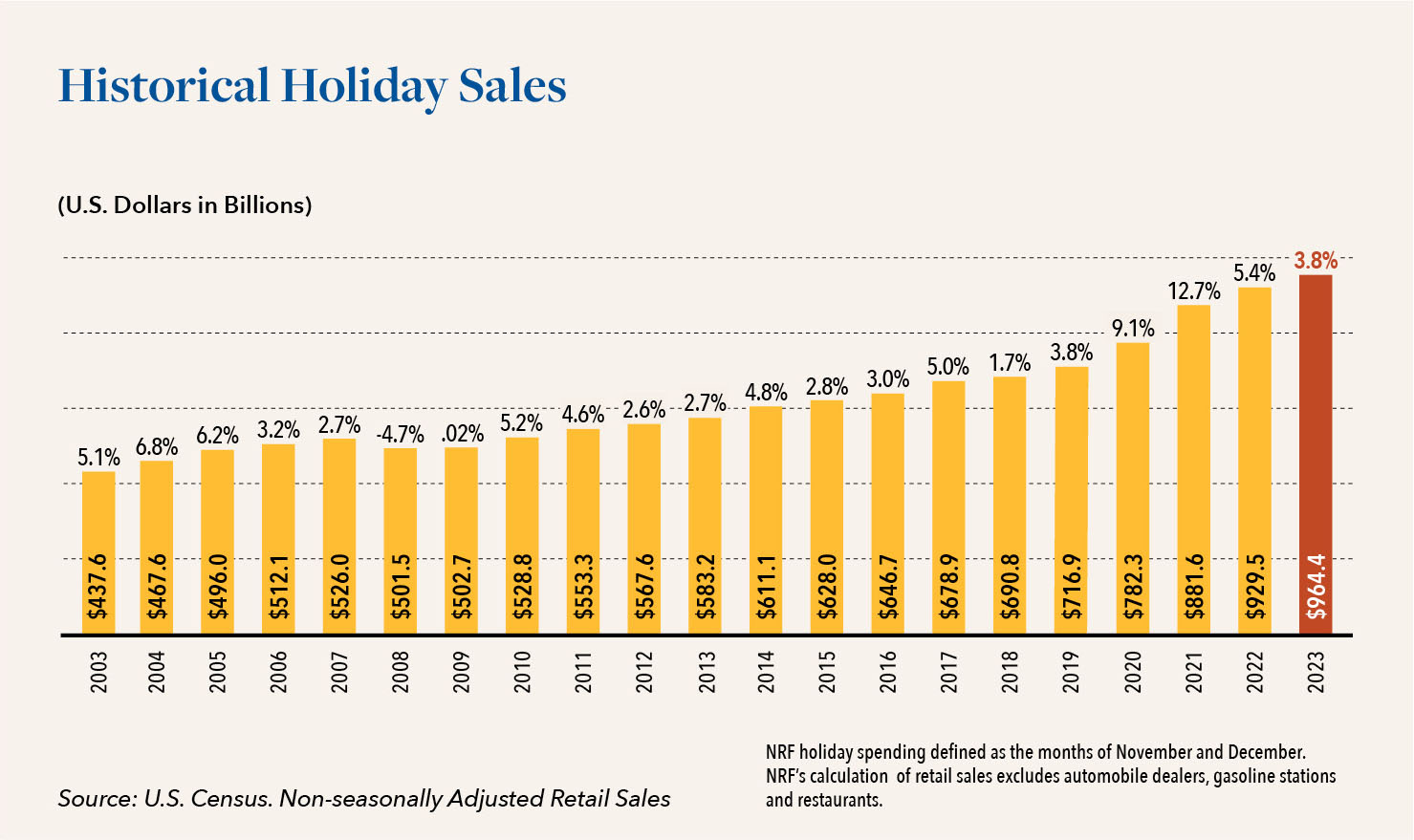Q1 Retail Sales Growth Expected, Purposeful Buying and Technology Investment Advised

Although high borrowing costs and tight credit conditions persisted for consumers, a strong job market and rising wages helped fuel consumer spending during the holiday shopping period in the final months of 2023.
Prior to the holidays, I stated my belief that — on a non-inflation adjusted basis — retail sales would increase 3-4% year over year, meaning it would keep pace with inflation. As predicted, total retail sales for the 12 months ended December 2023 were up 3.2 percent over the previous year, with holiday-focused sales during the final quarter of the year up 3.8 percent to more than $964 Billion, according to the National Retail Federation.
According to the U.S. Commerce Department, during the final month of 2023, sales at stores that sell general merchandise rose 1.3% and those that sell clothing and accessories increased 1.5%. With the housing market still struggling — mostly because of “inventory” shortages driven by higher mortgage rates and homeowners’ desire to stay put and keep their existing, lower mortgage — furniture and home furnishings sales declined 1%. Restaurant sales remained unchanged month over month and online sales increased 1.5%.

Outlook
We expect that the continued slowdown in inflation and the surprisingly robust increase in U.S. jobs added during January (employers added a whopping 353,000 jobs during the first month of 2024, alone) will bolster overall retail volume growth throughout this year, although depleted consumer savings, coupled with the high cost of food, is likely to limit the extent of that growth.
Retail brick and mortar stores will see sales increases, with discount retailers expected to perform particularly well in light of the factors referenced above. The foot traffic data trend has been positive for stores, with more strained consumers now returning to those physical locations to hunt for bargains in person. This has been spurred on in large part by the fact that once-generous online shipping and return policies have now been diminished or rescinded by many online sites. Given these and other developments, we are beginning to see more retailers explore targeted store expansion in the U.S. and elsewhere. With that said, we also expect significant retail store closings, which will likely result in a net reduction in stores over the course of 2024.
Technology Investment
August 2023 survey data from Legion Technologies indicates that more than 62% of hourly employees had plans
to leave their jobs within the coming 12 months. Retailers have been witnessing the exodus first-hand and scrambling to solve for the issue, which is impacting operations and bottom lines on a widespread basis. One solution has been to seek out younger, hourly workers to help bridge the gap, but this approach brings a fresh set of complications, including the younger generation’s focus on social responsibility and work/life balance. As the bargaining power of this younger group increases, retailers are faced with providing more competitive benefits and pay. The technological prowess of younger workers entering the retail ranks, however, can play positively into the hands of operators who are moving toward putting more advanced tools in the hands of front-line workers to gain efficiencies, better serve customers and improve their employee retention. Among this new breed of tools are offerings that require no IT integration cost and can operate on employee’s own handheld devices, delivering powerful collaboration and merchandising features.
Additionally, since ChatGPT became a household name, artificial intelligence has been the rage. While artificial intelligence has been used in recent years to aid in retail forecasting and supply chain management, the potential of generative AI is now enabling retailers to get closer to consumers by assisting them to identify products and services that best suit their needs and budgets under a wide range of circumstances. From compiling recipes and menus for themed gatherings to putting together outfits for special occasions or decorating rooms in specific styles, this technology can enable retailers to help shoppers search for products based on custom use cases rather than product by product or category by category. By investing in these capabilities and implementing them in this manner, operators can engage in a more relevant dialogue with consumers, provide them with a personal shopper-like experience, keep them within their branded universe longer, and link suitable recommendations to in-stock inventory that can then be added right into online shopping carts. This, in turn, can help to build brand preference and loyalty. However, retailers should be cautious about investing in this technology as it is in its infancy. Moreover, many technology firms over-promise and under-deliver, some are even using humans located overseas to provide their so-called “AI,” while they continue to develop an actual AI capability behind the scenes.
Purposeful Merchandising and Buying
As we head into spring we believe retailers should now be placing significant emphasis and effort on promoting and moving clearance merchandise. In addition to driving traffic, doing so will also create immediate liquidity (which many operators need right now), while limiting the costly burden associated with packing, shipping, storing and shipping that merchandise again at some future point in time — either to other store locations or future buyers of that excess, aging inventory.
Operators would also be wise to recognize that the consumer still remains largely constrained right now. For that reason, demonstrating restraint by limiting buys on non-needle movers is strategically advisable during 2024. When all is said and done, it is likely going to be more advantageous to run out of merchandise that sold at full price this year that it will be to have to discount it deeply to get rid of it late in the season.
Our team is maintaining a close eye on store traffic, sales volume, technology solutions, inventory levels and mix,
and other trends as we approach the midpoint of Q1 and we will plan to issue our next retail outlook update early in Q2. In the meantime, we encourage you to reach out to us to discuss any of the points raised above or to explore how we can assist with any current challenges you are now facing. We are here to help.




